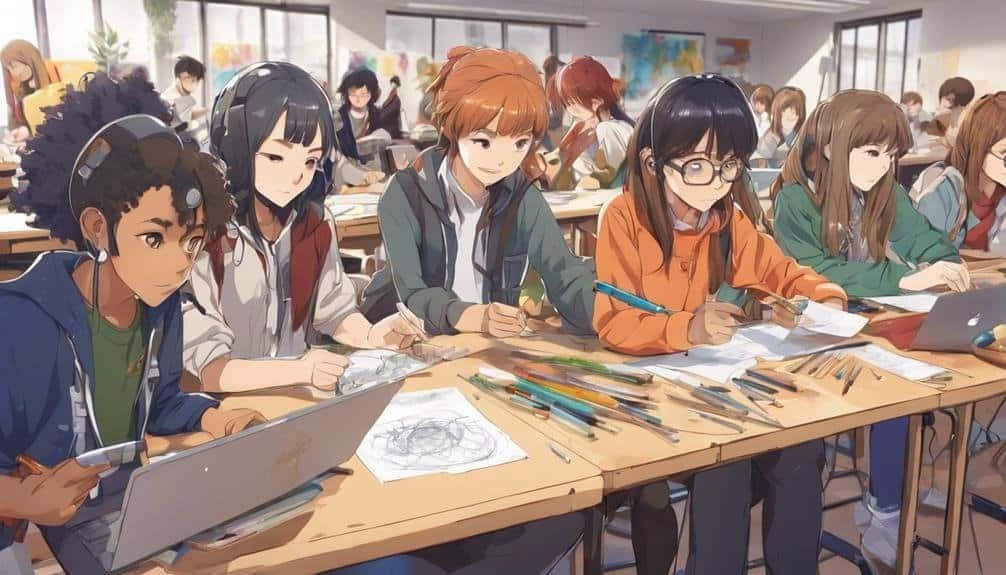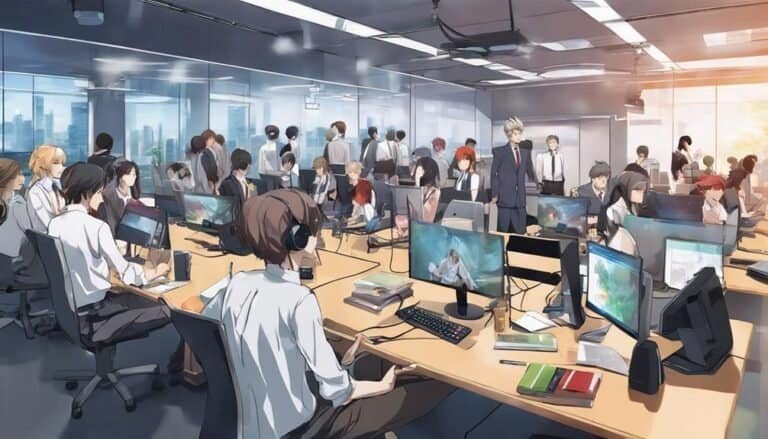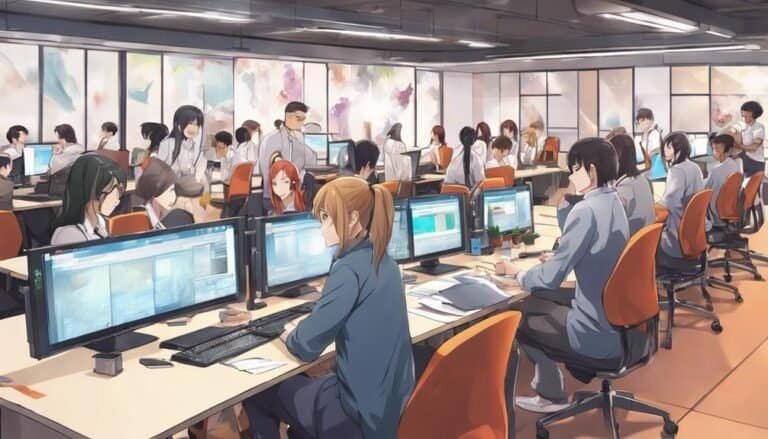Fostering Creativity in Learning: Innovative Approaches
In today's fast-evolving educational landscape, the cultivation of creativity in learning stands as a cornerstone for preparing students for the challenges of the future.
By exploring innovative approaches in education, educators can unleash the full potential of their students' creativity, leading to enhanced problem-solving skills, critical thinking abilities, and a deeper understanding of complex concepts.
With a focus on fostering creativity through unconventional methods, the possibilities for enriching the educational experience are endless.
This discussion will investigate various strategies and techniques that can revolutionize traditional learning paradigms and inspire a new generation of innovative thinkers.
Key Takeaways
- Embracing innovative teaching methods sparks creativity and enhances problem-solving skills.
- Integrating technology elevates engagement and understanding, fostering critical thinking.
- Collaborative learning cultivates teamwork, critical thinking, and real-world skills.
- Developing critical thinking nurtures creativity, problem-solving, and adaptability for future challenges.
Importance of Creativity in Education
In the domain of education, the importance of fostering creativity cannot be overstated as it serves as a catalyst for innovative thinking and problem-solving skills development. Creative thinking plays a pivotal role in shaping educational outcomes by encouraging students to explore new ideas, think outside the box, and approach challenges with a fresh perspective. By cultivating imagination, educators not only enhance academic success but also equip learners with the essential skills needed to thrive in a rapidly evolving world.
When students are encouraged to think creatively, they become active participants in their learning journey, engaging more deeply with the material and developing a deeper understanding of concepts. This active involvement leads to increased motivation, improved critical thinking abilities, and a greater sense of ownership over their education. Moreover, fostering creativity in education empowers students to become innovative problem solvers, preparing them for the complexities of the modern workforce where adaptability and creative thinking are highly valued.
Benefits of Innovative Teaching Methods
Exploring contemporary instructional strategies enhances educational experiences by discovering novel avenues for student engagement and learning outcomes. Innovative teaching methods offer various benefits that contribute to the overall effectiveness of education.
- Active Engagement: These methods promote active participation, where students are encouraged to interact with the material through discussions, debates, hands-on activities, and collaborative projects. This engagement helps in fostering a deeper understanding of the subject matter and enhances retention levels.
- Cognitive Development: Innovative teaching methods stimulate critical thinking, problem-solving skills, and creativity. By challenging students to think outside the box and apply their knowledge in practical scenarios, these methods enhance cognitive development and promote a deeper level of understanding.
- Personalized Learning: Many innovative teaching strategies allow for personalized learning experiences tailored to individual student needs. This approach helps in catering to diverse learning styles and preferences, ultimately leading to improved academic performance and overall student satisfaction.
Incorporating innovative teaching methods into educational practices can greatly enhance the learning process and contribute to the holistic development of students.
Technology Integration for Creative Learning
The integration of technology in education has revolutionized the way students learn and engage with content.
Digital tools designed for creativity allow students to explore their imagination and express ideas in innovative ways.
Additionally, virtual reality experiences provide immersive learning opportunities that can enhance comprehension and retention of complex concepts.
Digital Tools for Creativity
Amidst the evolving landscape of education, the integration of digital tools has emerged as a pivotal catalyst for fostering creativity and innovation in learning environments. Utilizing interactive platforms opens up avenues for engaging experiences and enables students to actively participate in their learning journey.
Additionally, digital storytelling serves as a powerful tool for students to express their creativity through multimedia elements, enhancing their narrative skills. Animation tools, when combined with graphic design synergies, provide students with the ability to bring their imaginative ideas to life visually, fostering a deeper understanding of concepts through visual representation.
- Interactive platforms for engaging experiences
- Digital storytelling for creative expression
- Animation tools and graphic design synergies for visual creativity
Virtual Reality Experiences
Incorporating virtual reality technology into educational settings offers a dynamic and immersive approach to enhancing creative learning experiences. Through immersive simulations, students can engage in interactive environments that stimulate their creativity and critical thinking skills.
Virtual reality experiences provide a unique opportunity for learners to explore concepts in a three-dimensional space, fostering a deeper understanding of complex subjects. By enabling students to interact with the content in a hands-on manner, virtual reality not only enhances retention but also encourages experimentation and innovation.
These interactive environments allow for personalized learning experiences, catering to diverse learning styles and preferences. Overall, integrating virtual reality into education holds immense potential for cultivating creativity and enhancing the learning process.
Encouraging Collaborative Projects and Group Work
Encouraging active participation through collaborative projects and group work enhances learning outcomes and fosters essential skills in teamwork and communication. When students engage in project-based collaboration, they not only deepen their understanding of the subject matter but also develop vital interpersonal skills that are invaluable in the real world. Here are key points vital understanding team dynamics is essential for successful collaboration.
Students learn to navigate different working styles, communicate effectively, and leverage individual strengths to achieve common goals. Project-Based Collaboration: Engaging in hands-on projects allows students to apply theoretical knowledge in practical scenarios. It encourages critical thinking, problem-solving, and creativity while working towards a shared objective.
Enhanced Learning: Collaborative projects create an interactive learning environment where students actively participate, share ideas, and learn from one another. This fosters a sense of community and mutual support, enriching the overall learning experience.
Implementing Design Thinking in the Classroom
Integrating design thinking into educational settings fosters creative problem-solving skills and encourages student-centered innovation.
By incorporating this approach in the classroom, students are empowered to think critically, collaborate effectively, and develop solutions to real-world challenges.
Design thinking not only enhances the learning experience but also equips students with valuable skills that are essential for success in the ever-evolving landscape of the 21st century.
Creative Problem Solving
Design thinking, a problem-solving framework rooted in creativity and innovation, is increasingly being integrated into educational settings to foster creative problem-solving skills among students. This approach encourages students to think outside the box and develop innovative solutions to complex problems.
In implementing design thinking in the classroom, educators can leverage various techniques to enhance students' creative problem-solving abilities:
- Encouraging Brainstorming Techniques: Promoting free-flowing idea generation.
- Fostering Creative Expression: Allowing students to explore diverse ways of expressing their ideas.
- Developing Critical Thinking Skills: Encouraging students to analyze and evaluate potential solutions critically.
Student-Centered Innovation
In the domain of education, the emphasis on nurturing student-centered innovation through the application of design thinking principles has gained significant traction as an effective strategy for cultivating creative problem-solving skills among learners.
This approach fosters personalized learning experiences by encouraging hands-on exploration and experimentation, allowing students to engage deeply with the material. Implementing inquiry-based learning methods further enhances this process, promoting critical thinking and analytical skills.
Additionally, utilizing project-based assessments provides students with opportunities to apply their knowledge in real-world contexts, fostering a deeper understanding of the subject matter. By integrating design thinking into the classroom, educators can empower students to become active participants in their learning journey, ultimately equipping them with the skills needed to thrive in an ever-evolving world.
Assessing and Nurturing Creative Skills
Assessment and cultivation of creative skills play an important role in fostering innovation and adaptability in educational settings. Creative assessments provide insights into students' unique abilities, allowing educators to tailor instruction to individual learning styles. Skill development is enhanced through personalized feedback, encouraging students to reflect on their work critically and make improvements. Emphasizing a growth mindset helps learners understand that their abilities can be developed with dedication and hard work, fostering resilience in the face of challenges.
- Creative assessments: These evaluations go beyond traditional tests, allowing students to demonstrate their understanding in innovative ways.
- Skill development: Through targeted exercises and projects, students can hone their creative abilities and apply them across various disciplines.
- Personalized feedback: Individualized comments and suggestions help students understand their strengths and areas for improvement, fostering continuous growth and learning.
Conclusion
To sum up, fostering creativity in learning is paramount for preparing students for the fast-paced world of tomorrow.
By integrating innovative teaching methods, technology, collaborative projects, and design thinking in the classroom, educators can cultivate the creative skills necessary for success.
It is vital to continuously assess and nurture these skills to make certain that students are equipped to meet the challenges of the digital age.
Creativity is not a luxury but a necessity in today's competitive landscape.







